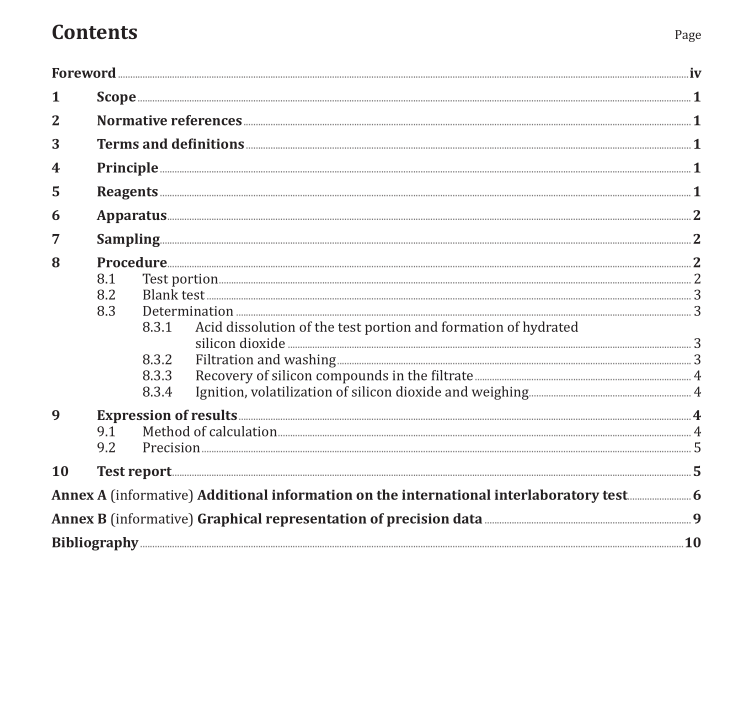DIN EN ISO 439:2020 pdf download.Steel and cast irons – Determination of silicon content – Gravimetric method (ISO 439:2020)
This document specifies a gravimetric method for the determination of the silicon content in steel and cast iron.
The method is applicable to silicon contents between 0,10 % (mass fraction) and 5,0 % {mass fraction).
NOTE For samples containing molybdenum, niobium, tantalum, titanium, tungsten, zirconium or high levels of chromium, the results are less accurate than for unalloyed matrixes.
2 Normative references
The following documents, in whole or in part, are normatively referenced in this document and are indispensable for its application. For dated references, only the edition cited applies. For undated references, the latest edition of the referenced document (including any amendments) applies.
ISO 3696, Water for analytical laboratory use — Specification and test methods
ISO 14284, Steel and iron — Sampling and preparation of samples for the determination of chemical composition
3? Terms? and? definitions
No terms and definitions are listed in this document.
ISO and IEC maintain terminological databases for use in standardization at the following addresses:
— ISO Online browsing platform: available at https://www.iso.org/obp
— IEC Electropedia: available at http://www.electropedia.org/
4 Principle
Dissolution of a test portion with hydrochloric and nitric acids.
Conversion of acid-soluble silicon compounds to hydrated silicon dioxide by evaporation with perchloric acid until white fumes appear. Filtration of the hydrated silicon dioxide and acid-insoluble silicon compounds, ignition to form impure silicon dioxide and then weighing.
Treatment of the ignited residue with hydrofluoric and sulfuric acids, followed by ignition and weighing.
5 Reagents
During the analysis, unless otherwise stated, use only reagents of recognized analytical grade and grade 2 water as specified in ISO 3696.
5.1 Hydrochloric acid, ρ approximately 1,19 g/ml.
5.2 Hydrochloric acid solution, 1 + 1.
Add 500 ml of hydrochloric acid (5.1) to 500 ml of water and mix.
5.3 Hydrochloric acid solution, 1 + 19.
Add 10 ml of hydrochloric acid (5.1) to 190 ml of water and mix.
5.4 Nitric acid solution, 3 + 1.
Add 150 ml of nitric acid, ρ approximately 1,40 g/ml, to 50 ml of water and mix.
5.5? Hydrofluoric? acid, ρ approximately 1,14 g/ml.
5.6 Perchloric acid, ρ approximately 1,67 g/ml.
WARNING — Perchloric acid vapour may cause explosions in the presence of ammonia, nitrous fumes or organic material in general.
NOTE Perchloric acid (ρ approximately 1,54 g/ml) can also be used.
5.7 Sulphuric acid solution, 1 + 1.
Cautiously add 50 ml of sulphuric acid, ρ approximately 1,84 g/ml, to 50 ml of water, allow to cool and mix.
6 Apparatus
Ordinary laboratory equipment and the following shall be used:
6.1 Platinum crucibles, of capacity approximately 30 ml.
6.2? Muffle? furnace, adjustable from 800 °C up to 1 100 °C.
6.3 Filter paper, medium-texture, of known low ash content.
7 Sampling
Carry out sampling in accordance with ISO 14284 or appropriate national standards for steels and cast irons.
8 Procedure
8.1 Test portion
Use millings or drillings of a maximum thickness of 0,2 mm.
According to the presumed silicon content, weigh, to the nearest 1 mg, the following mass (m 0 ) of the test portion:
a) for silicon contents between 0,10 % (mass fraction) and 0,50 % (mass fraction): m 0 approximately 5 g;
b) for silicon contents between 0,50 % (mass fraction) and 2,5 % (mass fraction): m 0 approximately 2,5 g;
c) for silicon contents between 2,5 % (mass fraction) and 5,0 % (mass fraction): m 0 approximately 1 g.
8.2 Blank test
In parallel with the determination and following the same procedure, carry out a blank test using the same quantities of all reagents as used for the determination.
8.3 Determination
8.3.1 Acid dissolution of the test portion and formation of hydrated silicon dioxide
Place the test portion (8.1) in a beaker of suitable capacity.
Add 30 ml of hydrochloric acid (5.1), and then gently heat the beaker covered with a watch glass until the reaction ceases. Oxidize by careful addition of 15 ml of nitric acid (5.4). When the violent reaction ceases, rinse the watch glass with a little portion of hot water and collect the washings in the beaker.
Add the volume of perchloric acid (5.6) indicated in Table 1.DIN EN ISO 439 pdf download.DIN EN ISO 439 pdf download
